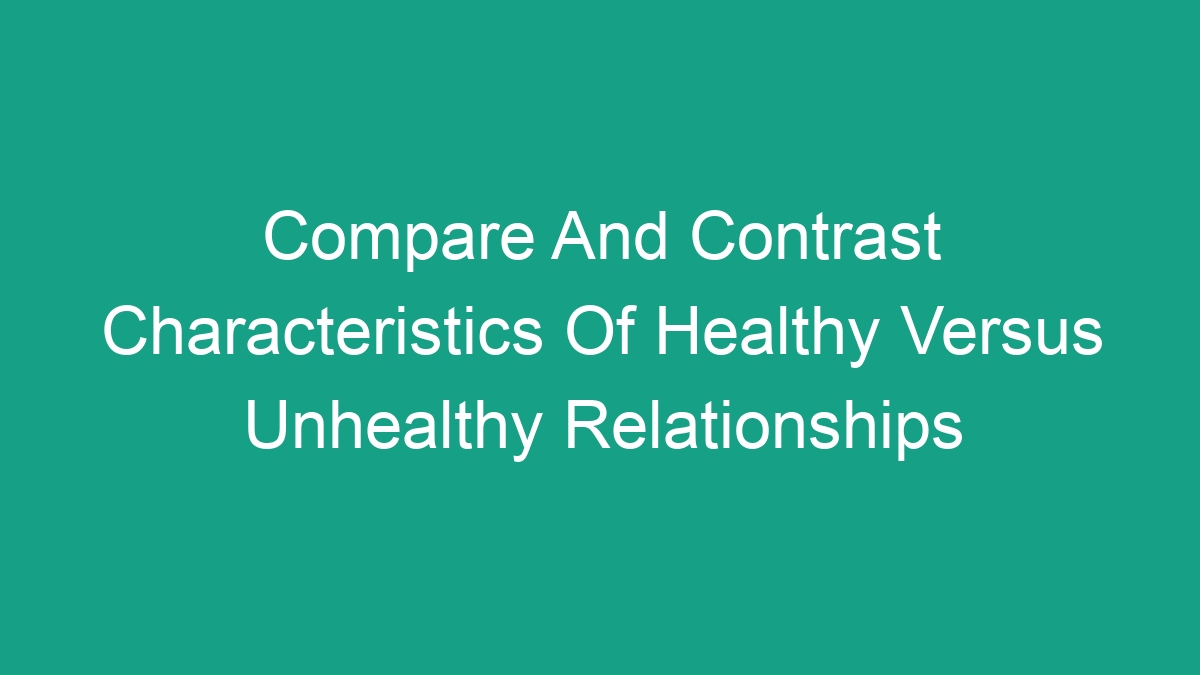
Introduction
Relationships are an integral part of our lives, as they contribute to our overall well-being and happiness. Whether it’s a romantic relationship, a friendship, or a familial bond, the dynamics of the relationships we engage in significantly impact our mental and emotional health. In this article, we will compare and contrast the characteristics of healthy versus unhealthy relationships, providing insight into what constitutes a positive and fulfilling connection versus a toxic and harmful one.
Communication
Healthy: Effective communication is a cornerstone of a healthy relationship. In a healthy relationship, individuals communicate openly and honestly, expressing their thoughts, feelings, and needs without fear of judgment or reprisal. Listening actively, showing empathy, and validating each other’s experiences are also integral to healthy communication.
Unhealthy: In unhealthy relationships, communication is often marked by a lack of transparency, competition, or defensiveness. Conflict may escalate, and individuals may resort to manipulation, passive-aggressiveness, or outright hostility instead of resolving issues through open dialogue.
Trust
Healthy: Trust is earned and maintained in healthy relationships. Individuals can rely on each other and have confidence in their partner’s integrity, reliability, and intentions. There is a sense of security and support, and both parties feel comfortable being vulnerable with each other.
Unhealthy: In unhealthy relationships, trust is undermined by dishonesty, betrayal, and a lack of consistency. Individuals may feel suspicious, insecure, or anxious about their partner’s actions and motives, leading to a heightened sense of fear and doubt.
Respect
Healthy: Mutual respect is a fundamental aspect of healthy relationships. Individuals in healthy relationships demonstrate consideration, appreciation, and understanding for each other. They honor each other’s boundaries, autonomy, and individuality, fostering a sense of equality and esteem in the relationship.
Unhealthy: Disrespectful behavior is prevalent in unhealthy relationships, characterized by belittling, controlling, or demeaning actions. One or both parties may feel disregarded, devalued, or disrespected, leading to a contentious and unbalanced relationship dynamic.
Support
Healthy: Healthy relationships provide a nurturing and supportive environment for individuals to grow and thrive. Both parties offer emotional, practical, and moral support to each other, promoting each other’s well-being and personal development.
Unhealthy: In unhealthy relationships, support may be lacking or conditional. Individuals may feel unsupported, neglected, or dismissed in times of need, leading to feelings of isolation and inadequacy.
Boundaries
Healthy: Respect for personal boundaries is a key characteristic of healthy relationships. Individuals in healthy relationships have a clear understanding of each other’s boundaries and demonstrate a willingness to honor them. There is a sense of trust and safety in expressing individual needs and limits.
Unhealthy: In unhealthy relationships, boundaries may be disregarded or violated. Individuals may feel pressured to sacrifice their autonomy, privacy, or values, leading to a sense of intrusion and discomfort.
Collaboration
Healthy: Collaboration and teamwork are prevalent in healthy relationships. Individuals work together to address challenges, make decisions, and achieve mutual goals. There is a sense of unity and cooperation, fostering a harmonious and supportive partnership.
Unhealthy: Unhealthy relationships may be marked by a lack of collaboration, with one or both parties prioritizing their individual interests over the relationship as a whole. Conflict and competition may overshadow cooperation, leading to discord and disharmony.
Growth
Healthy: Healthy relationships encourage personal and relational growth. Individuals feel inspired, empowered, and motivated to evolve and improve themselves within the context of the relationship. There is a sense of possibility and optimism regarding the future.
Unhealthy: In unhealthy relationships, growth may be stifled or impeded. Individuals may feel stagnant, restricted, or inhibited from realizing their full potential, leading to feelings of frustration and disillusionment.
Balance
Healthy: Healthy relationships are characterized by a sense of balance and harmony. Both parties contribute equally to the relationship, sharing responsibilities, compromises, and joys. There is a sense of equilibrium and fairness in the relationship.
Unhealthy: Unhealthy relationships may be marked by imbalance and inequity. One party may dominate the relationship, leading to feelings of resentment, powerlessness, and dissatisfaction for the other party.
Conclusion
In conclusion, it is evident that healthy and unhealthy relationships differ significantly in their characteristics and impact on our well-being. By understanding and recognizing the hallmarks of healthy relationships, individuals can cultivate and nurture positive connections that enhance their lives. Conversely, identifying the warning signs of unhealthy relationships enables individuals to address and rectify detrimental dynamics, fostering a healthier and more fulfilling relational landscape.
It is essential to remember that healthy relationships are built on mutual respect, trust, communication, support, and collaboration, contributing to personal and relational growth. By prioritizing the cultivation of these qualities and recognizing and addressing the absence of these traits in relationships, individuals can create and sustain relationships that are fulfilling, nourishing, and uplifting.



